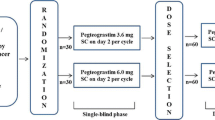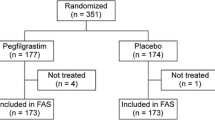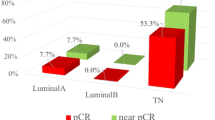Abstract
Amrubicin is a synthetic anthracycline which has been shown in preclinical studies to have broad-spectrum anti-tumor activity and a lower potential for cardiotoxicity as compared to doxorubicin. We conducted a phase 1/2 trial of single-agent amrubicin as second- or third-line treatment for women with metastatic breast cancer. Women with metastatic HER2-negative breast cancer who had normal cardiac function and measurable disease, received intravenous (IV) amrubicin every 3 weeks. Prophylactic treatment with granulocyte colony-stimulating factors (G-CSFs) was recommended. Escalating amrubicin doses were administered in a 3 + 3 design in the phase 1 portion to determine the maximum tolerated dose. Achievement of a median PFS ≥4.5 months would warrant further development of amrubicin in this setting. Seventy-eight women (median age 58 years) were treated (phase 1, 15 patients; phase 2, 63 patients). An amrubicin dose of 110 mg/m2 every 3 weeks was selected as the phase 2 dose, and 66 patients were treated. Twelve of 66 patients (18 %) achieved objective response, and the clinical benefit rate was 42 %. Median PFS was 4 months (95 % CI 2.5, 5.8). Neutropenia was the most common grade 3/4 toxicity, observed in 29 patients (44 %). One patient experienced an asymptomatic transient left ventricular ejection fraction decline (grade 3). Although the study did not meet the predefined PFS, amrubicin was well tolerated at 110 mg/m2 IV when administered every 3 weeks with prophylactic G-CSF, and was an active second- or third-line treatment for metastatic HER2-negative breast cancer.


Similar content being viewed by others
References
Siegel R, Naishadham D, Jemal A (2013) Cancer statistics, 2013. CA Cancer J Clin 63:11–30
Norris B, Pritchard KI, James K et al (2000) Phase III comparative study of vinorelbine combined with doxorubicin versus doxorubicin alone in disseminated metastatic/recurrent breast cancer: National Cancer Institute of Canada Clinical Trials Group study MA8. J Clin Oncol 18:2385–2394
Joensuu H, Holli K, Heikkinen M et al (1998) Combination chemotherapy versus single-agent therapy as first- and second-line treatment in metastatic breast cancer: a prospective randomized trial. J Clin Oncol 16:3720–3730
Ejlertsen B, Mouridsen HT, Langkjer ST et al (2004) Phase III study of intravenous vinorelbine in combination with epirubicin versus epirubicin alone in patients with advanced breast cancer: a Scandinavian Breast Group trial (SBG9403). J Clin Oncol 22:2313–2320
Nielsen D, Dombernowsky P, Larsen SK et al (2000) Epirubicin or epirubicin and cisplatin as first-line therapy in advanced breast cancer. A phase III study. Cancer Chemother Pharmacol 46:459–466
Keller AM, Mennel RG, Georgoulias VA et al (2004) Randomized phase III trial of pegylated liposomal doxorubicin versus vinorelbine or mitomycin C plus vinblastine in women with taxane-refractory advanced breast cancer. J Clin Oncol 22:3893–3901
Stoodley PW, Richards DA, Boyd A et al (2013) Left ventricular systolic function in HER2/neu negative breast cancer patients treated with anthracycline chemotherapy: a comparative analysis of left ventricular ejection fraction and myocardial strain imaging over 12 months. Eur J Cancer 49:3396–3403
Hanada M, Mizuno S, Fukushima A et al (1998) A new antitumor agent amrubicin induces cell growth inhibition by stabilizing topoisomerase II–DNA complex. Jpn J Cancer Res 89:1229–1238
Yamaoka T, Hanada M, Ichii S et al (1998) Cytotoxicity of amrubicin, a novel 9-aminoanthracycline, and its active metabolite amrubicinol on human tumor cells. Jpn J Cancer Res 89:1067–1073
Salvatorelli E, Menna P, Surapaneni S et al (2012) Pharmacokinetic characterization of amrubicin cardiac safety in an ex vivo human myocardial strip model. I. Amrubicin accumulates to a lower level than doxorubicin or epirubicin. J Pharmacol Exp Ther 341:464–473
Eisenhauer E, Therasse P, Bogaerts J et al (2009) New response evaluation criteria in solid tumors: revised RECIST guideline (version 1.1). Eur J Cancer 45:228–247
NCI common terminology criteria for adverse events (CTCAE) v.4. National Cancer Institute. http://evs.nci.nih.gov/ftp1/CTCAE/about.html. Accessed 30 Oct 2012
Inoue A, Sugawara S, Yamazaki K et al (2008) Randomized phase II trial comparing amrubicin with topotecan in patients with previously treated small-cell lung cancer: North Japan Lung Cancer Study Group trial 0402. J Clin Oncol 26:5401–5406
Ettinger DS, Jotte R, Lorigan P et al (2010) Phase II study of amrubicin as second-line therapy in patients with platinum-refractory small-cell lung cancer. J Clin Oncol 28:2598–2603
Jotte R, Conkling P, Reynolds C et al (2011) Randomized phase II trial of single-agent amrubicin or topotecan as second-line treatment in patients with small-cell lung cancer sensitive to first-line platinum-based chemotherapy. J Clin Oncol 29:287–293
Jotte R, Von Pawel J, Spigel DR et al (2011) Randomized phase III trial of amrubicin versus topotecan (Topo) as second-line treatment for small cell lung cancer (SCLC). ASCO Meet Abstr 29:7000
Acknowledgments
This study was supported by a Grant from Celgene.
Conflict of interest
Denise A. Yardley, MD—Consultant/advisory role: Celgene (uncompensated). All other authors declare that they have no conflict of interest.
Author information
Authors and Affiliations
Corresponding author
Rights and permissions
About this article
Cite this article
Yardley, D.A., Raefsky, E., Hainsworth, J.D. et al. Amrubicin as second- or third-line treatment for women with metastatic HER2-negative breast cancer: a Sarah Cannon Research Institute phase 1/2 trial. Breast Cancer Res Treat 148, 535–540 (2014). https://doi.org/10.1007/s10549-014-3189-y
Received:
Accepted:
Published:
Issue Date:
DOI: https://doi.org/10.1007/s10549-014-3189-y




